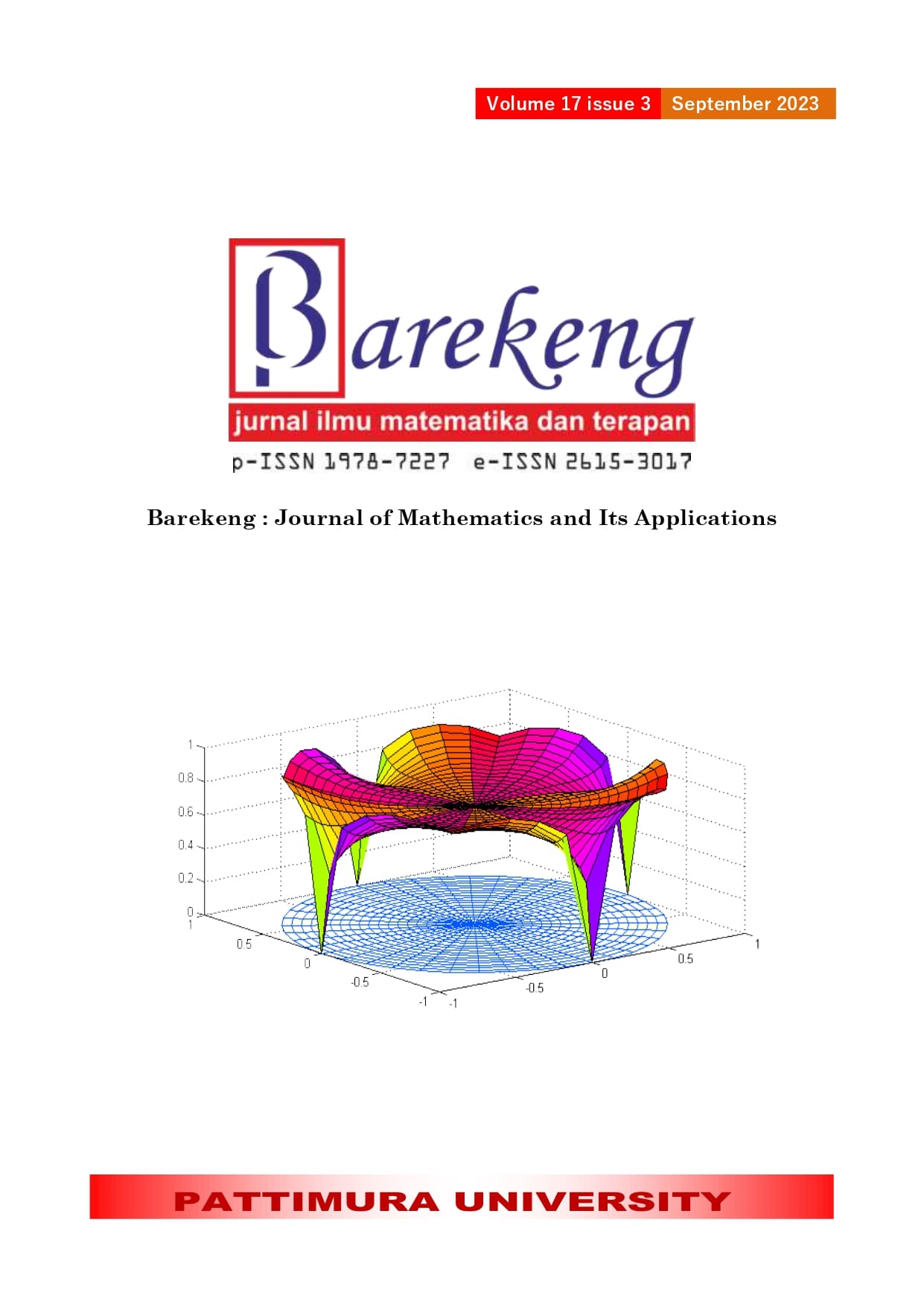THE APPLICATION OF DISCRETE HIDDEN MARKOV MODEL ON CROSSES OF DIPLOID PLANT
Abstract
The hidden Markov model consists of a pair of an unobserved Markov chain {Xk} and an observation process {Yk}. In this research, the crosses of diploid plant apply the model. The Markov chain {Xk} represents genetic structure, which is genotype of the kth generation of an organism. The observation process represents the appearance or the observed trait, which is the phenotype of the generation of an organism. Since it is unlikely to observe the genetic structure directly, the Hidden Markov model can be used to model pairs of events and unobservable their causes. Forming the model requires the use of the theory of heredity from Mendel. This model can be used to explain the characteristic of true breeding on crosses of diploid plants. The more traits crossed, the smaller probability of plants having a dominant phenotype in that period. Monohybrid, dihybrid, and trihybrid crosses have a dominant phenotype probability of 99% in the seventh, eighth, and ninth generations, with the condition of previous generations having a dominant phenotype. But in seventh generation, monohybrid crosses only have the probability of an optimal genotype of 50%, dihybrid crosses have a probability of an optimal genotype of 25% in the eighth generation, and trihybrid crosses have a probability of an optimal genotype of 12.5% in the ninth generation
Downloads
References
L. A. Urry, M. L. Cain, S. A. Wasserman, P. V. Minorsky and R. Orr, Campbell Biology 12th Edition, San Francisco: Pearson, 2021.
Kastolan, B. Setiawaty and N. K. Ardana, “Point and Figure Portfolio Optimization using Hidden Markov Models and Its Application on the Bumi Resources Tbk Shares,” InPrime: Indonesian Journal of Pure and Applied Mathematics, vol. 3, no. 1, pp. 44-52, 2021.
L. D. Borchers, W. Zucchini, M. Heide‐Jørgensen, A. Cañadas and R. Langrock, “Using hidden Markov models to deal with availability bias on line transect surveys,” Biometrics, vol. 69, no. 3, pp. 703-713, 2013.
P. D. Harris, A. Narducci, C. Gebhardt, T. Cordes, S. Weiss and E. Lerner, “Multi-parameter photon-by-photon hidden Markov modeling,” Nature Communications, vol. 13, pp. 1-12, 2022.
J. H. Hsiao, J. An, V. K. S. Hui, Y. Zheng and A. B. Chan, “Understanding the role of eye movement consistency in face recognition and autism through integrating deep neural networks and hidden Markov models,” npj Science of Learning, vol. 7, pp. 1-13, 2022.
N. Mousavi, M. Monemian, P. G. Daneshmand, M. Mirmohammadsadeghi, M. Zekri and H. Rabbani, “Cyst identification in retinal optical coherence tomography images using hidden Markov model,” Scientific Reports, vol. 13, pp. 1-15, 2023.
E. Marco, W. Meuleman, J. Huang, K. Glass, L. Pinello, J. Wang, M. Kellis and G.-C. Yuan, “Multi-scale chromatin state annotation using a hierarchical hidden Markov model,” Nature Communications, vol. 8, pp. 1-9, 2017.
F. Mohammadi, S. Visagan, S. M. Gross, L. Karginov, J. Lagarde, L. M. Heiser and A. S. Meyer, “A lineage tree-based hidden Markov model quantifies cellular heterogeneity and plasticity,” Communications Biology, vol. 5, pp. 1-14, 2022.
Y. Marchuk, R. Magrans, B. Sales, J. Montanya, J. López-Aguilar, C. d. Haro, G. Gomà, C. Subirà, R. Fernández, R. M. Kacmarek and L. Blanch, “Predicting Patient-ventilator Asynchronies with Hidden Markov Models,” Scientific Reports, vol. 11, pp. 1-7, 2018.
R. Ludwig, B. Pouymayou, P. Balermpas and J. Unkelbach, “A hidden Markov model for lymphatic tumor progression in the head and neck,” Scientific Reports, vol. 11, pp. 1-17, 2021.
T. Nguyen, A. Khosravi, D. Creighton and S. Nahavandi, “Hidden Markov models for cancer classification using gene expression profiles,” Information Sciences, vol. 316, pp. 293-307, 2015.
M. Momenzadeh, M. Sehhati and H. Rabbani, “Using hidden Markov model to predict recurrence of breast cancer based on sequential patterns in gene expression profiles,” Journal of Biomedical Informatics, vol. 111, pp. 1-9, 2020.
M. Momenzadeh, M. Sehhati and H. Rabbani, “A novel feature selection method for microarray data classification based on hidden Markov model,” Journal of biomedical informatics, vol. 95, pp. 1-8, 2019.
S. Thorvaldsen, “A tutorial on Markov models based on Mendel's classical experiments,” Journal of Bioinformatics and Computational Biology, vol. 3, pp. 1441-1460, 2005.
L. R. Rabiner, “A tutorial on hidden Markov models and selected applications in speech recognition,” in Proceedings of the IEEE, Scottsdale, 1989.
Copyright (c) 2023 Nahrul Hayati, Berlian Setiawaty, I Gusti Putu Purnaba

This work is licensed under a Creative Commons Attribution-ShareAlike 4.0 International License.
Authors who publish with this Journal agree to the following terms:
- Author retain copyright and grant the journal right of first publication with the work simultaneously licensed under a creative commons attribution license that allow others to share the work within an acknowledgement of the work’s authorship and initial publication of this journal.
- Authors are able to enter into separate, additional contractual arrangement for the non-exclusive distribution of the journal’s published version of the work (e.g. acknowledgement of its initial publication in this journal).
- Authors are permitted and encouraged to post their work online (e.g. in institutional repositories or on their websites) prior to and during the submission process, as it can lead to productive exchanges, as well as earlier and greater citation of published works.






1.gif)



